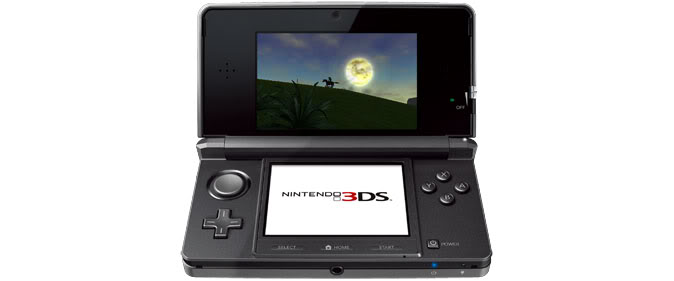
The Nintendo 3DS’s graphics aren’t the only thing that will be popping out of the screen. With the implementation of “CrossPass” mode, your 3DS game profile and data will be bursting out as well.
With the pervasiveness of social media, most consumers are no longer n00bs when it comes to sharing information publicly. People share billions of details of their lives across multiple social networks, often with pictures and video to boot.

A screen capture of 3DS's exchanging CrossPlay data on a train from the 3DS conceptual demo.
The 3DS’s “Crosspass,” a tag mode where the 3DS automatically swaps user data with other units, doesn’t sound so crazy against this cultural backdrop. The timing with communications in pop culture could be just right.
CrossPass seems to be the next logical progression in Nintendo handheld communications, especially when put in perspective with how communication in general has evolved.
If you compare Nintendo handheld communications to the development of phones and telecommunications, you'll find the company is usually right on track.
Fully wired — The rotary phone and the original Game Boy
Let’s start with the rotary phone, the epitome of all cord-based communication. It’s wildly outdated, clunky, and requires lots of tangled wires but still retains some retro charm — a status that sounds a little like how gamers revere the original Game Boy in its archaic 8-bit glory.
The original Game Boy could connect two players through a single short link cable or up to four players through an ugly plastic hub called the Game Boy Four-Player Adapter. Multiplayer on the Game Boy required sitting really close to the other player and occasionally wiggling link cables to connect. Like calling friends on hard-wired home phones that only had a 15-inch cord, this was not the most comfortable situation. But its greatness was in the mere fact that it worked, and allowed us to communicate in the first place.

"Connecting a Pokémon battle on line one…"
Wireless in name only — The cordless phone and Game Boy color
Cordless home phones seemed slick when my family bought one in the early 90s. My Game Boy Color’s infrared port, which allowed minimal wireless multiplayer communications for a few games, seemed like a great idea, too. Both ideas nosedived in coolness factor when I discovered I still had to stand very to the cordless phone cradle to get reception, and, with the Game Boy Color, I had to sit awkwardly close to Player 2, hope for minimal wireless interference, and pray that Player 2 didn’t have stinky breath. It was the same wired experience just without the wires — not a great improvement.
Then came the Game Boy Advance and SP era, which was disappointing in terms of communication. Nintendo released the triangle-shaped Game Boy Advance Wireless Adapter, which allowed short-range wireless communications on a few games (namely Pokémon FireRed and LeafGreen). The GBA/SP multiplayer still leaned heavily on wires and connecting to external devices like the GameCube and the eReader. For me, this was the lull in technology before cell phones hit critical mass.
Finally breaking free, getting connected — The cell phone and DS
The DS and its following iterations finally freed Nintendo portable multiplayer from cables, as cell phones finally unhooked consumer telephone communications from wires and wall jacks. Eventually, I could even communicate with people outside of my zip code for minimal costs and connect to the Internet from both devices.
 As cell phones improved and morphed into smart phones, they became able to handle an assortment of applications and plug-ins that let you access social media networks on the go and added to the echo chamber of interconnectivity.
As cell phones improved and morphed into smart phones, they became able to handle an assortment of applications and plug-ins that let you access social media networks on the go and added to the echo chamber of interconnectivity.
Entering the hive mind — Smart phones, social media and the 3DS
The 3DS’s Crosspass mode looks like an attempt to keep stride with the constant-contact trends that social media and cell phones have brought into the fold of pop culture. The concept demo shows the 3DS acquiring a non-stop stream of information, focusing on one 3DS player who downloads new data from Wi-Fi and other 3DS users from the moment she wakes up until she go to sleep.
Tag modes have been available on past DS games like Nintendogs, Animal Crossing: Wild World, and The World Ends With You. But many factors have to go right in order for two players to exchange data: they both have to have the same game, the game must be set on tag mode, the players have to be in close together, and it helps if the moon is full while Neptune and Mars are aligned on the second Thursday of the month.
In day-to-day communications and gaming multiplayer, we seem to be slowly creeping our way toward developing the collective consciousness of the Borg hive mind. My Twitter account shows me tweets from what other gamers have recently played on Raptr. Facebook updates from friends tune me into what they have played recently.
But I choose to follow other gamers on these networks. CrossPass is about locally connecting everyone. By the innocuous act of simply passing a person on the street, we'll know each others' gaming rapsheets but probably won't meet in person to ever play games. This random information and background noise gets translated into collective knowledge and unnescessary facts our culture easily accepts and craves.
Do you welcome CrossPass automatically sharing your data? Do you think it will be a legitimate form of randomly trading game data, or will it be another silly gimmick? What 3DS titles would you like to see CrossPass use?
Although, in a couple more gaming generations I probably won’t even need to ask this. We would have already shared our answers via the 4DS’s ThoughtPass.



